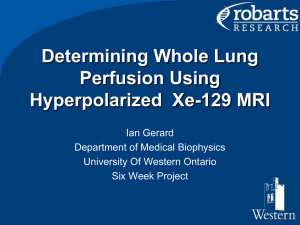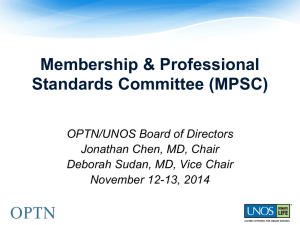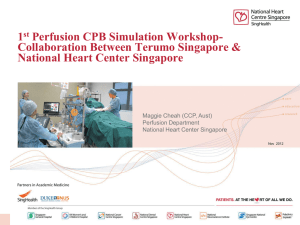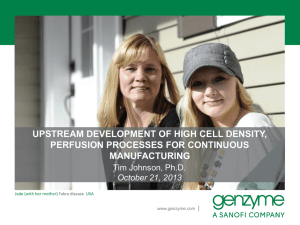s4_heartperfusion
advertisement
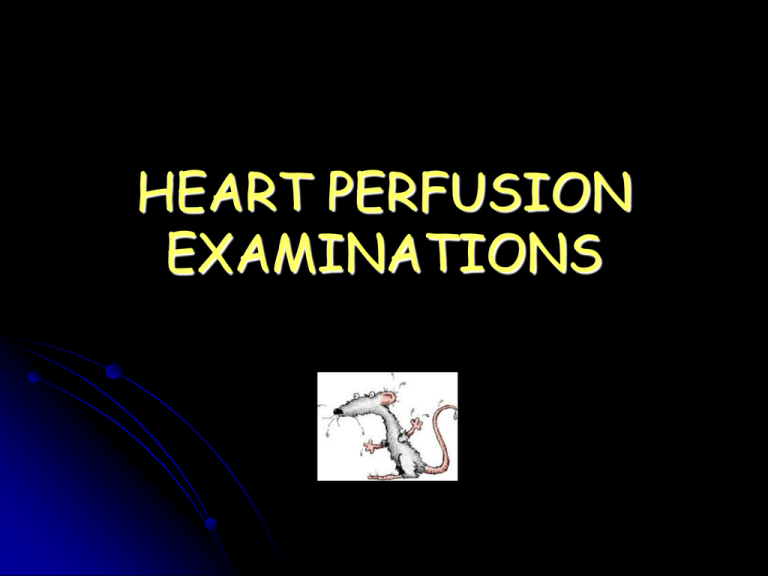
HEART PERFUSION EXAMINATIONS ADVANTAGES OF IN VITRO HEART PERFUSION STUDIES Can be studied quickly and in large number Highly reproducible Enables biochemical, physiological, morphological studies Absence of confounding effect of organs, systemic circulation, neurohumoral factors Drugs, hormones can be added exogenously in a controlled manner Dose-response studies Can be studied for several hours Regional/global ischemia – anoxia/hypoxia - studies Induction of arrhythmias ECG – mapping and ablation of conduction pathways SPECIES FOR PERFUSION Mammalian/non-mammalian hearts (frog, bird) Large animal hearts: Most frequently studied: Pig, monkey, sheep, dog High cost, greater variability, large volumes of perfusion fluids, special equipment Rat, rabbit, guinea pig, hamster, ferret, mouse Transgenic technology Mouse hearts: small, high heart rate Rat: best characterized, most frequently used, ease of handling Difficulties: Rat: short action potential Rabbit: anesthesia Guinea pig: collateralized vasculature HEART PERFUSION PREPARATIONS LANGENDORFF HEART PERFUSION SYSTEM „WORKING-HEART” PREPARATION DESCRIBED BY NEALY LANGENDORFF HEART PREPARATION MODES OF PERFUSATE DELIVERY: -constant flow rate -constant hydrostatic pressure -Shattock electrical feedback system Used with hearts from mice, rats, guinea pigs, rabbits LANGENDORFF PERFUSION OF RAT HEART PREPARATION I. Anesthesia: Inhalation of agents (ether, halothane or metoxyflurane) Injection: (i.p., i.v.) (pentobarbitone) Anticoagulation: Excision of the heart from the donor animal Immersion of heart in cold perfusion solution (40C) Heparin 18 Cannulation of the heart ! Air emboli ! Coronary ostia ! Aortic valves LANGENDORFF PERFUSION OF RAT HEART PREPARATION II. Washout period for 10 minutes Instrumentation: Contractile function measurements: -Open tip pressure transducer with intraventricular balloon – intraventricular pressure, heart rate monitoring Pace -bipolar silver wire electrode ECG -stainless steel cannula „Workingheart” Preparation Advantages: -filling pressures and afterload can be controlled Used with hearts from rats, dogs, pigs PERFUSION TEMPERATURE Near or at the normal body temperature 37.0-37.50C Temperature control: -Thermostatically regulated cabinet in which warm air is circulated - Thermostatically controlled water-jacketed system Avoid over-heating ! Parameters determined during heart perfusion I. Morphology and vascular anatomy Biochemistry Arterio-venous differences in substrates, metabolites (lactate, oxygen, proteins, enzymes) Biopsies, NMR spectroscopy: on-line measurement of high energy phosphates, metabolites, ions Microelectrodes: ions, pH, action potential Delivery of vectors in gene transfer studies Conduction pathway mapping and selective ablation Light/electron microscopy Microbiopsies Fixation by perfusion Cardiac rhythm and electrophysiology Parameters determined during heart perfusion II. Cardiac contractile function Pharmacology Systolic, diastolic pressures, cardiac pump function Echo techniques – pressure volume relationships, indices of contractile function Various therapeutic agents, dose-response studies Great speed and reproducibility, drugs can be easily washout Vascular biology Vascular reactivity, endothelial and smooth muscle function Interventions on coronary flow and its distribution COMPOSITION OF PERFUSION FLUID Krebs-Henseleit pH=7.4 NaCl: 118.5 mM, NaHCO3: 25.0 mM, KCl: 4.7 mM, MgSO4: 1.2, KH2PO4: 1.2, glucose: 11.0 mM, CaCl2: 2.5 mM Calcium? Calcium and phosphate? Glucose? Fatty acids? Edema? Filtration: 5 μm filter OXYGEN DELIVERY DURING PERFUSION Gassed perfusion solution: 95% oxygen + 5% CO2 Perfusion with asanguinous perfusion fluids Perfusion with blood Perfusion with oxygen-carrying hemoglobin substitutes Required to the correct pH In case of addition of fatty acids or proteins membrane oxigenator is recommended Parabiotic preparation with support rat BLOOD PERFUSION -Decrease of hematocrit to 2830% with Gelofusine solution -Ventilation of support rat with 95% oxygen -Control of body temperature, blood pressure, breathing Less edema Stable heart function Almost physiological coronary flow rate Blood elements (neu) Support animal? ERYTHROCYTE PERFUSION Washed red blood cells Membrane oxygenator Hematocrit of 25-40% Blood cells from different species – sheep Stability Less edema Immunological reactions 31P NMR SPECTROSCOPY/ LANGENDORFF HEART PERFUSION Ischemia – blood supply is less than the required amount Reperfusion – restoration of blood flow after coronary occlusion Ischemic preconditioning – short repeated ischemic episodes evokes the preconditioning of the heart (that means cardioprotection during the next longer ischemic period ) ENERGY METABOLISM IN THE STRIATED AND HEART MUSCLE Striated muscle Mitochondria Basic act. ++ Heart muscle +++++ FFA (adipose tissue) keton bodies (liver) Medium act. FFA FFA +++ keton bodies blood glucose blood glucose + keton bodies + Max. act. +fermentation of glycogen +creatine-phosphate + creatine-phosphate Energy metabolism. mostly aerobic fully aerobic max. act. - anaerobic Energy pools glycogen creatine-phosphate creatine-phosphate (glycogen ) CREATINE/PHOSPHOCREATINE TRANSFORMATION REPRESENTATIVE 31P NMR SPECTUMS OF HIGH ENERGY PHOSPHATES Pi PCr γ-P α-P β-P ATP IR+G IR I N CrP (norm oxiás é rté k %-a) RECOVERY OF CREATINE PHOSPHATE AFTER ISCHEMIA-REPERFUSION IN LANGENDORFF PERFUSED HEART 120 100 80 60 40 20 0 3 6 9 3 15 30 3 6 9 perfúziós idő (perc) Kontroll IR IR+L-2286 10 µM IR+L-2286 20 µM 12 15 DETERMINATION OF HEART FUNCTION Insertion of a latex balloon into the left ventricle End-diastolic pressure 8-12 mmHg Selection of hearts: on the basis of the stability of high-energy phosphates (assessed by NMR) Normoxia 15min, ischemia 25 min, reperfusion 45 min Functional data: LVEDP=left ventricular end-diastolic pressure LVDP=levt ventricular developed pressure RPP=rate pressure product HR=heart rate dP/dt LVDP=levt ventricular developed pressure 89.25 Hgmm HR=heart rate RPP=rate pressure product dP/dt 9.25 Hgmm 0 msec 1000 msec 25.5 Hgmm 8.5 Hgmm 0 msec 1000 msec LVEDP=left ventricular end-diastolic pressure DOXORUBICIN-INDUCED DETERIORATION OF HEART FUNCTION
